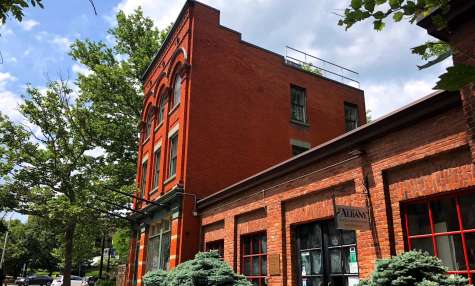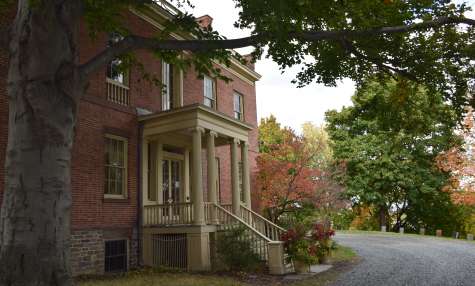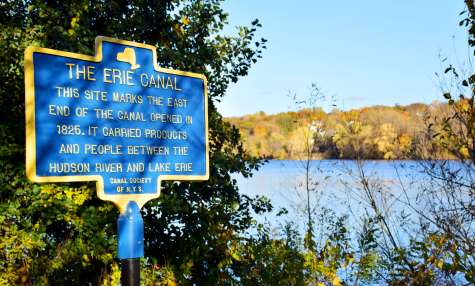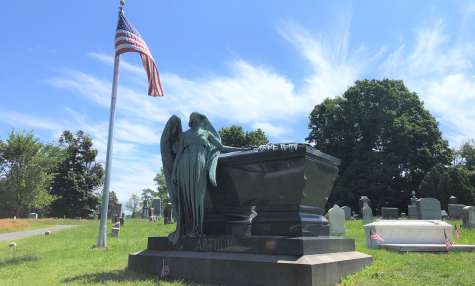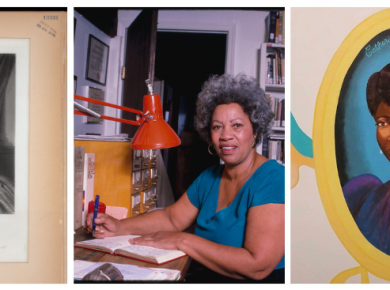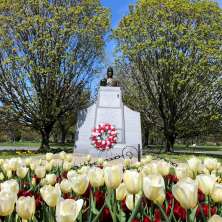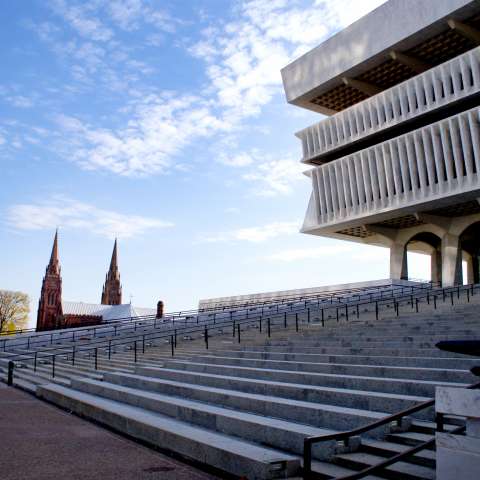

History of Albany
-
Events Calendar
-
Annual Events and Festivals
- Albany Chefs' Food & Wine Festival
- NYS Writers Institute's Albany Film Festival
- Annual Albany Tulip Festival
- Lupine Fest
- Baseball Hall of Fame Induction Weekend
- Alive at Five
- Capital Pride Festival
- Dad Fest
- 4th of July Celebrations in Albany
- Albany Latin Fest
- Albany Riverfront Jazz Festival
- PearlPalooza
- NYS Writers Institute's Albany Book Festival
- Old Songs Music Festival
- Capital District Scottish Games
- Hops & Harvest
- Free Summer Event Series
- Halloween & Haunted Events
- Holiday Celebrations
- Juneteenth Celebrations
- Festival of Nations
- Live Music
- Team Sports
- Submit an Event
-
Annual Events and Festivals
- Arts & Entertainment
- Tours & Itineraries
- Albany's All-Hallow E'en Festival
Show Less in: Things to Do
Show Less in: Restaurants
History of Albany
Take a deeper dive into Albany's history with a virtual tour of the Albany Heritage Exhibit!
Albany has a rich history dating back more than 400 years. When Henry Hudson arrived in 1609, the area was already home to the Haudenosaunee (Iroquois) and the Dutch had established a trading post.
In 1797, Albany became the official capital of New York State. Since then, Albany has been a center for banking, railroads, and international trade. Four New York state governors went on to become President of the United States.
The telegraph, electric motor, and celluloid plastic were all pioneered here. Albany was also the point of origin for the first long distance airplane flight and the first passenger railroad.
Trace our unique place in American history at the New York State Museum, Albany Institute of History & Art, or any of our beloved heritage sites.

A Detailed History of Albany
Henry Hudson's 1609 voyage northward ended near Albany, where the river that bears his name became impassible for his ship. His Dutch sponsors built Fort Nassau on Westerlo Island in 1614, serving as an administrative outpost for the fur trading ventures of the Dutch West India Company in Manhattan. Ice and floods damaged this first fort, which was first relocated around 1615 to land at the mouth of the Normans Kill, then replaced by the larger Fort Orange further north in 1623. Begun as an outpost of Manhattan, Fort Orange was to become a permanent settlement, with Dutch and French Huguenot families among its first inhabitants.
Related Sites & Attractions:
The Dutch encouraged settlement through the manor system, with tenant farmers paying rent to the Manor of Rensselaerswyck, purchased by the Van Rensselaer family in 1629 and covering most of what is now Albany and Rensselaer Counties. The West India Company formally established the village of Beverwijck in 1652, independent of the Manor. In 1664 when the Dutch surrendered to the British without a battle, King Charles II granted territory including New Netherland, New England, Long Island and Delaware to his royal brother James, the Duke of both York and Albany. Thus Beverwyck became Albany and New Amsterdam became New York. Albany remained under British rule until the American Revolution.
Related Sites & Attractions:
Albany County was the northernmost and least developed of the ten original counties created within the Colony of New York on November 1, 1683. Undefined on the north and west, its eastern portion included much of Vermont and the southern area reached Dutchess and Ulster Counties. In 1772, Albany County was divided into thirds, with the northwest portion named Tryon County (later Montgomery) and the northeast area called Charlotte (renamed Washington.) During the next three decades, six new counties would be created from Albany County's much-reduced territory, the last, Schenectady County, in 1808.
In 1686 Governor Thomas Dongan granted a charter to the City of Albany. Albany County's other cities were chartered late in the nineteenth century. Soon after, settlers had spread throughout the County, and most of the present County towns were established, beginning with Watervliet in 1788.
In 1754 at the Stadt Huys (City Hall) leaders of the several colonies met to develop a common defense against the French. The document identified as The Albany Plan of Union was drafted with Benjamin Franklin as one of the chief authors. However, it was never adopted by Parliament. Between 1757 and 1763 Albany became the hub of military planning during the French and Indian War, although the French never invaded the city.
With increased economic and political tensions between the colonies and sovereign England, Albany supported the First Continental Congress in Philadelphia. During the war years (1775-1783) because of its central location on the Hudson River, Albany was a useful supply center as well as a focal point for military planning. Albany native Philip Livingston was one of the signers of the Declaration of Independence.
Related Sites & Attractions:
Among those involved in the military campaigns were Albany's sons, Generals Philip Schuyler, Peter Gansevoort and Abraham Ten Broeck. At what is known as the war's turning point, with Burgoyne's surrender at Saratoga, Burgoyne became a prisoner guest at the Schuyler Mansion (now a state historic site). It was a mansion that played host to many notables of the era including George Washington, Alexander Hamilton, John Jay and Aaron Burr.
With the formation of a state government, New York's legislature first met in Kingston, and continued to convene annually in New York City and Albany. In 1797 the decision was made to establish Albany as its permanent capital.
Related Sites & Attractions:
The first commercial enterprise in Albany County was the fur trade, but with the founding of the Manor of Rensselaerswyck, agriculture became the leading economic activity, centered on wheat for local consumption and export to New York City. Sheep and dairy farming became important after the construction of the Erie Canal in the 1820's and the railroads in the 1830's and 40's. These events enabled wheat farmers in the western part of the State and Nation to compete with those in the east, and local farmers turned to more profitable ventures in dairy and cattle-raising. The waterways, railroads and highways of Albany County have been the backbone of its success, first in trading, then in manufacturing, and finally in government, banking, retail commerce, and the burgeoning nanotechnology industry.
During the 19th century, the city's population continued to expand with a variety of ethnic groups from Europe, the majority of which were Irish, German and Jewish. Albany became a city of craftsmen and limited manufacture with politics playing an ever-vital role in the community.
Related Sites & Attractions:
Among those for whom politics was more than a passing phase was Martin Van Buren. He was the founder of the Albany Regency, the first political machine and he went on to become president of the United States. In holding elective office was Ira Harris and behind the scene politician and publisher Thurlow Weed. In addition to Van Buren spanning the 19th and 20th centuries among the governors who advanced to the presidency were Grover Cleveland, Theodore and Franklin Roosevelt. Not a governor, but U.S. president whose gravesite is located in Albany Rural Cemetery, was Chester A. Arthur. Although Governor Charles Evans Hughes did not become president, he served as Chief Justice of the U.S. Supreme Court.
For over 200 years, Albany has been New York's capital. The County is also a center for banking, retail, non-profit organizations, railroads, and international trade via the port of Albany. The City of Albany is the County seat and largest community, followed by the suburban towns of Colonie, Guilderland, and Bethlehem. Seven other towns and two small cities complete the picture of the county that lies at the junction of the Hudson and Mohawk rivers.
Related Sites & Attractions:
Learn more about Albany's History
Guide to Juneteenth Celebrations in Albany County
Celebrate Juneteenth in Albany County! This historic holiday commemorating what is considered to be More
9 Women Who Made Their Mark on History with Ties to Albany
From left to right, Elizabeth Schuyler image sourced from The New York Public Library Digital More
How to Celebrate Black History in Albany This Month & Beyond
February marks Black History Month in the United States. This year, let Black History Month serve as More







